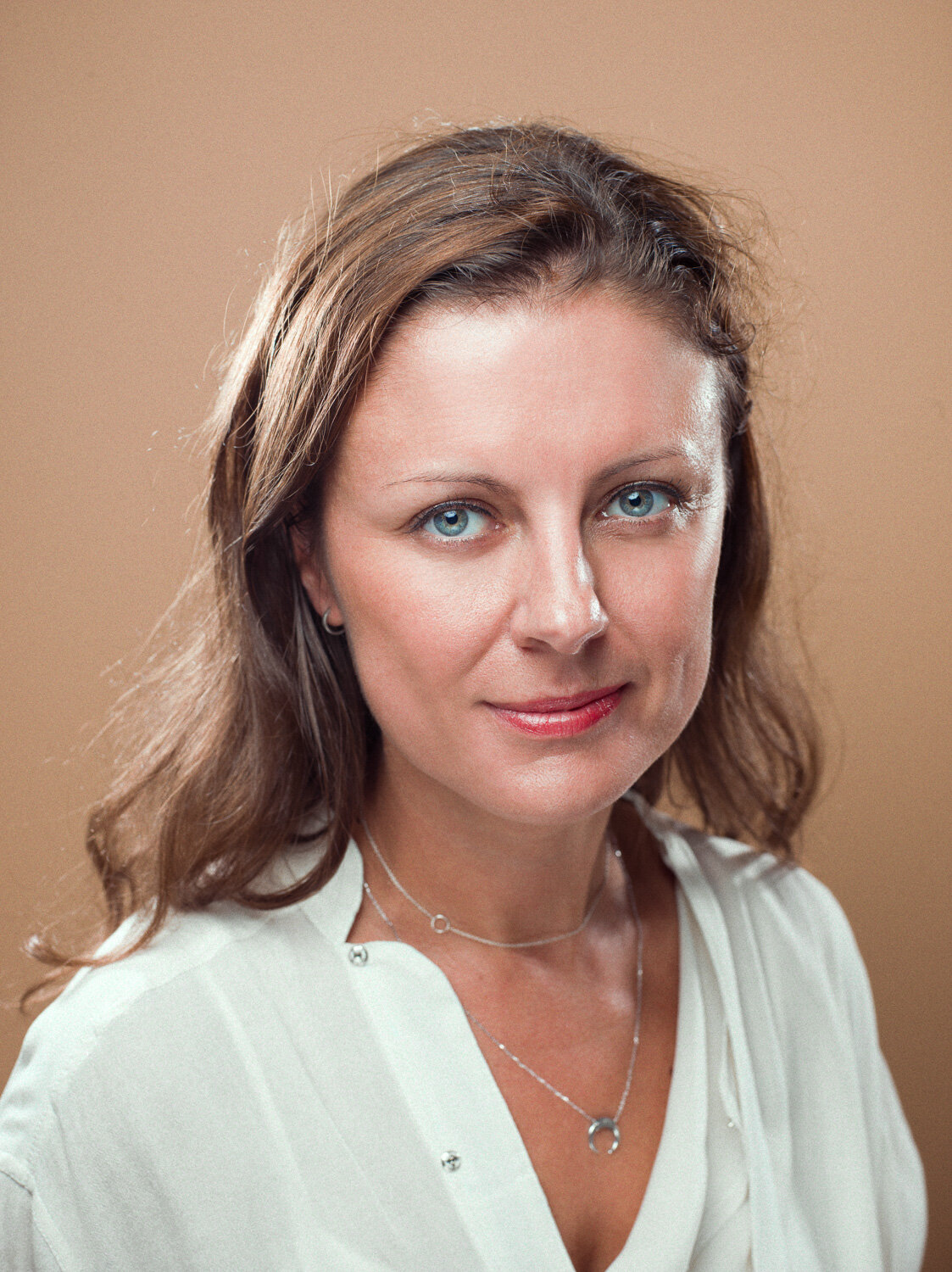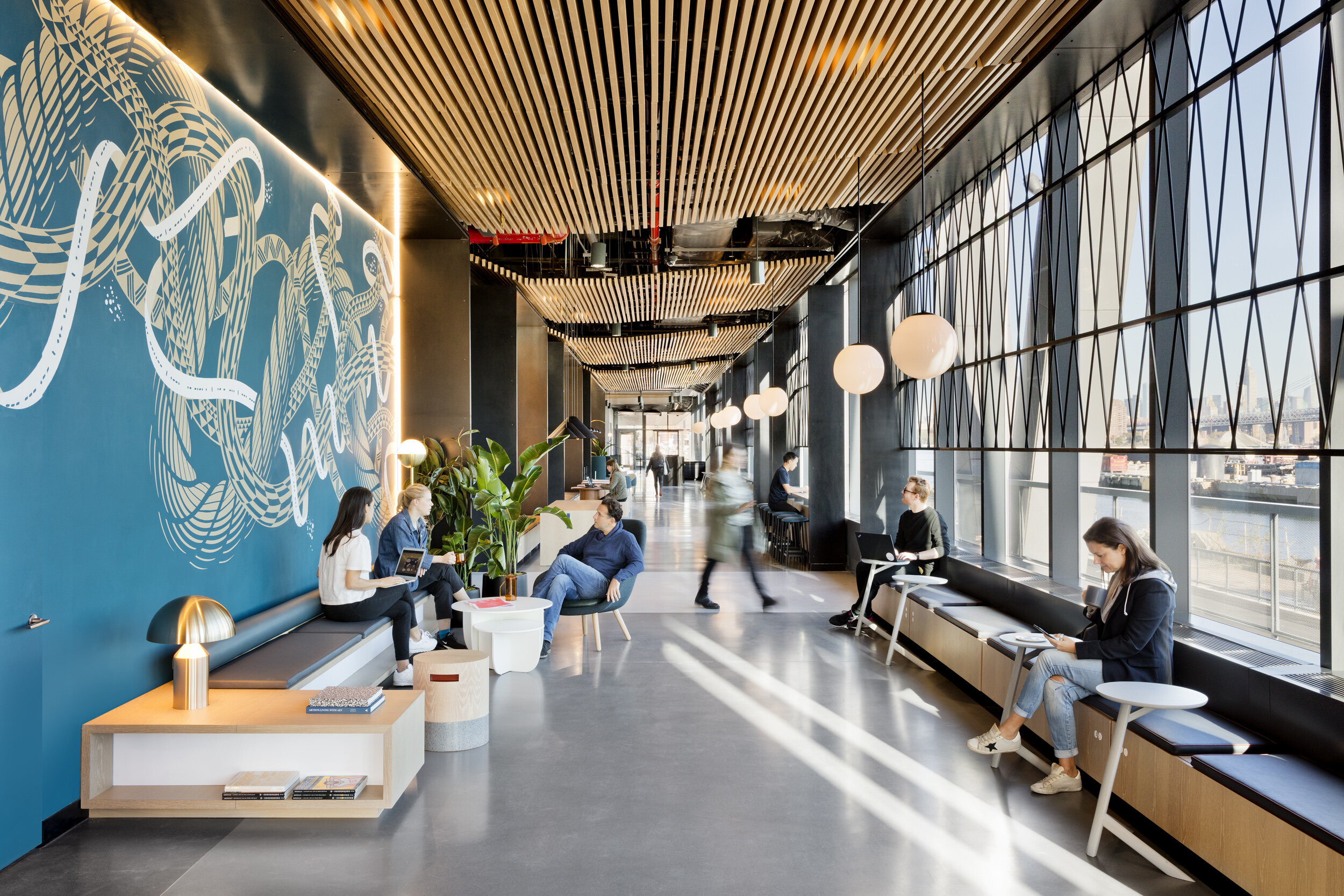Spaces for Balance: Fogarty Finger's Alexandra Cuber on Mentorship, Excellent Design, and Healthy Environments
Portrait by Mike Allen Photography.
By Julia Gamolina
Alexandra Cuber has lived in Germany and Spain and has spent most of her 20-year career in New York City. Her career began as an exterior architect for many high-rise projects and museums including the Perez Art Museum. In 2011, she joined Fogarty Finger, where she leads the hospitality interiors studio. She conveys her strong design sensibility to projects including Brooklyn Navy Yard’s public and amenity spaces, a new commercial amenity campus, headquarter build-outs and a boutique hotel in downtown Manhattan.
Alexandra holds a Diploma in Architecture from University of Applied Science of Cologne, Germany and a Master of Architecture from Universidad Politecnica de Catalunya, Spain. She is a Registered Architect, AIA member and LEED AP. She is an advocate for women and minorities and a passionate mentor for young talent. In her interview with Julia, Alexandra talks about her focus on building in New York and on healthy spaces, advising young architects to follow their passions.
JG: You are originally from Germany! Tell me about how you grew up and how an interest in architecture developed from that.
AC: I was actually born in Poland, and then when I was three we moved to Germany. I grew up in a small town next to the Rhine, and my interest for architecture started very early on because my grandfather was an architect. He was one of my idols, and him always sketching and drawing was something I always noticed and admired.
The mid-century modern bar and lounge at 1700 Broadway Club in midtown Manhattan. Photo by Connie Zhou.
A detail of the classic wood bar at 1700 Broadway Club. Photo by Connie Zhou.
What did you learn both about the field, and about yourself, by then studying architecture?
I was always very comfortable in that mix of design and engineering, especially in Germany, where my school’s focus was very practical. Then I studied in Spain, which was more focused on design, so I feel like I got a very good mix. In general, I learned that I thrived in feeling very free within a certain amount of constraints.
How did you get your start?
I started my career in New York. Even when I was living and studying in Europe, I was always attracted to the city, so when I finished my Masters in Barcelona, I specifically looked for a job in New York. The scale and energy was always something I was drawn to.
I started with an internship at SOM in June of 2001. Three months later, I witnessed the twin towers collapsing. I remember running for my life. That experience had a huge impact on my life, on everyone’s lives, and as scary as it was, it created a really strong connection to New York City for me. I had a strong need to get back to the city, to contribute to rebuilding it, and somehow the universe answered this by making me a part of the first team who worked on the first master plan for the site, and then the Freedom Tower. This was super fulfilling for me.
In the very beginning, I had this grand plan of spending a year in New York, and then Tokyo, and then who knows where else - I’m a nomad by heart - but I’m still here these years later. You can see that my relationship with New York is quite serious [laughs].
“I had a lot of great mentors, mentors who taught me how to lead by nudging people and giving them guidance, instead of telling them exactly what to do.”
Mine too. How did you get to Fogarty Finger?
Well first, I’d like to say that my time at SOM felt like a third degree for me. I came to a very fast-paced and demanding environment, but working with such talented people and learning a tremendous amount. My experience there felt like a true stepping stone, and those three years of training opened a lot of doors. After SOM, I went to Pei Cobb Freed and Partners, and then ended up at Handel Architects.
I was at Handel for six years, and I love looking back at that time because I had a lot of great mentors, mentors who taught me how to lead by nudging people and giving them guidance, instead of telling them exactly what to do. Handel taught me how to mentor really well, and now I’m focused on paying that forward in mentoring others.
Design-wise, Handel was the Architect of Record for many Herzog & de Meuron projects in the States, from Bond Street to the Perez Art Museum in Miami. I was lucky to be part of those teams, and working with the Herzog & de Meuron team both in our, and in their office, showed me that good design can be pushed and pushed further to become excellent design. That really honed my approach and raised the bar of expectations.
I finally came to Fogarty Finger in 2011, and I was part of the ground-up projects team. Until then, I only did ground up architecture, but since I started here, I slowly but surely moved into interior architecture. That was probably my need for a new challenge and new things, as well as for things to be more fast-paced.
The Fogarty Finger team at the ribbon-cutting for Dock 72 at the Brooklyn Navy Yard, featuring Alexandra Cuber, fifth from left, with founding partners Robert Finger and Chris Fogarty, third and fourth from left, respectively. Photo courtesy of Fogarty Finger.
Pictured here is a mural by Dan Funderburgh in the art-lined lobby of Dock 72 at the Brooklyn Navy Yard. Photo by Connie Zhou.
Where do you feel like you’re in your career today?
When I started with Fogarty Finger ten years ago, I was the ninth employee. We were a small team then, so I’ve helped shape and grow the firm over the years. When the pandemic hit, we were 130 people! So throughout these ten years, I’ve of course moved from a production role into a leadership role. It was very nice to be part of that change and growth, because I’ve been able to focus on ensuring a very balanced work environment, and mentor all the talent that we have here to succeed.
Throughout your career, what have been some of the biggest challenges for you?
The biggest challenge is the work and life balance [laughs]. I’m lucky that I love what I do, and my career is a big part of my lifestyle, but of course it’s still hard to find that balance. Right now I’m really living it - I’m working from Costa Rica, and so I surf in the morning before I start work, which has been amazing. The pandemic has taught me a lot about balancing everything, since for a long time, all the lines were blurred as we were working from home, and I found myself working more.
“...we want people to take the vacation and encourage them too...when people come back from their break, they are more productive, more aware, healthier. They bring energy and inspiration back! Instead of the mentality that vacation is for leisure, I think we need to see it as very productive for everyone.”
We’re trying to focus on creating more opportunities for our staff to have that kind of balance, and to be able to work remotely. I’m working from Costa Rica for example, so that I could surf, others are choosing places perhaps where they can hike or be close to nature in other ways, and that was really hard to do before. Focusing on helping people find their own balance has been great. Better lives create better work.
I remember when I came to New York from Europe and all of the sudden I got ten vacation days per year. That was a shock to my core [laughs]. This is so unhealthy, and so unproductive! Fogarty Finger gives twenty days right off the bat, and I think this is changing in our industry in general because I’m seeing offices give more and more time off to their staff. With the pandemic, I think people are realizing how important mental health is, how important a healthy work environment is, and I hope this will all influence our industry and our work culture in the right direction.
The dapper, light-filled interiors of a workplace renovation. Photo by Connie Zhou.
The rounded walls of the Rockefeller Group’s headquarters encourage transparency among the company’s different departments. Photo by Connie Zhou.
Is that twenty days for all employees, including junior staff?
Yes! Everyone!
That’s fantastic.
And we want people to take the vacation and encourage them too. I’m sometimes almost upset when I see that people don’t because when people come back from their break, they are more productive, more aware, healthier. They bring energy and inspiration back! So instead of the mentality that vacation is for leisure, I think we need to see it as very productive for everyone. And this is a German talking [laughs].
What are you most proud of in your career so far?
Besides the projects, I am most proud of being where I am right now in my position as a Director. I feel that I can really create change for the young talent in our studio, which is both really rewarding and humbling. Being at a place where you can guide people to their highest potential is very fulfilling.
What would you say your mission is, for the profession?
That’s a loaded question [laughs]. I want to be an advocate for healthy, inspiring, and welcoming work environments. Creating that both for the talent here at Fogarty Finger, as well as for our clients, is what I’m focused on. Our surrounding affect us, I think everyone realized that after being stuck at home for days and months - which is why a lot of people started renovating and redecorating. I want to contribute to making spaces that make us feel good and support our lives, and also de-stress us. And this is for work environments, for hotel environments, any commercial space. We’ve all been at home for so long, that I think there will be a trend of bringing aspects of home to the office later on.
“We’ve all been at home for so long, that I think there will be a trend of bringing aspects of home to the office later on. ”
Who are you admiring right now?
I really admire the young people that I mentor. The way that they develop and advance themselves further is something that has been incredible to watch. I also really like what Michelle Obama does, and Barack too. They both invest so much in young people - in terms of education, in terms of helping young people find their calling. That’s very inspiring.
Finally, what advice do you have for those just starting out in the industry?
Choose your profession out of passion, not practicality. You will only be happy if your heart is in it. My dad always advised me as a kid to pick my job wisely. You don’t want to be miserable for eight hours daily. And in architecture, it’s more of a 12-hour commitment, because creativity has no time limit. When you imagine your next goal, instead of envisioning your title or your salary, exchange it for a feeling. See yourself being happy and fulfilled. And finally, go and travel, when we all can again! It’s the best source of inspiration out there.






